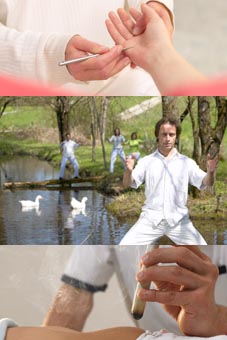Additionally to chinese herbal treatment manual therapy plays a supporting role in the clinic Silima. Especially following therapies are often used in the clinic:

The sound-desk is in it´s appearence similar to a normal therapeutic desk but smaller and without any cushioning. The material used for this desk is similar to the one used for pianos. Under this plate about 25 strings are drawn in longitudinal direction, and all of these strings are tuned on the same tone pitch. As the therapeut plays beneath the patient a longlasting and very harmonic tone (overtone) accures. The patient lying on the desk doesn´t only hear the tone through the ears, but feels it in his whole body as a vibration or bodysound, lasting longer than the duration of the treatment.
In Japane Shiatsu includes the whole japanes massagemethodes that are based on chinese medicine. The applied methodes depend on the individual situation and disturbance of meridians. Through rotation and stretching the tension in muscles, ligaments and joints get relaxed, to get free floating energy in the meridians. That´s why Shiatsu is used for dysfunctions of the whole musculoskeletal system. Beside that Shiatsu regulates the breathing, during the treatment the „natural“ rhythmn of breath shows up. This is the first step for activating the selfhealingsystem, to start the healing of the body.
Tuina integrates the manual techniques of massage, the active and passive mobilisation and the chiropractical techniques of chinese medicine. The word Tuina composes of Tui (to push) and na (to hold). It is used for orthopedic, acute injuries, but also for inner disturbances and has a much more intensive effect than conventional massage. Depending on the indication there is a wide range of special tuina techniques from very fast massage, affording a good bodycontrol of the therapeut, to soft floating movement.
The Acupunctmassage (APM) was developed in the 1970ies in Germany and combines the knowledge of chinese medicine about the meridians with manual techniques of western medicine. No needles are used for this kind of therapy. It is indicated for problems with the joints, e.g. spine-, shoulder- or kneeproblems, and is often used in our clinic for treatment of scars and problems with healing of wounds.
Qigong summarizes a large amount of practical exercises that where developed in china for active movement of the qi. In the traditional chinese medicine QiGong is the active part of practise, meaning the part oneself can do on his own to keep healthy and to support the healing process. The word QiGong is composed of „Qi“, that can be interpretated as the „vital energy“, and „gong“ meaning „persistantly training“. Starting with a relaxed bodyposition you go on to slowly floating movements, which are often imitated from animals and nature phenomenons. The slow movements regulate the floating of the breath and harmonise biological functions.
